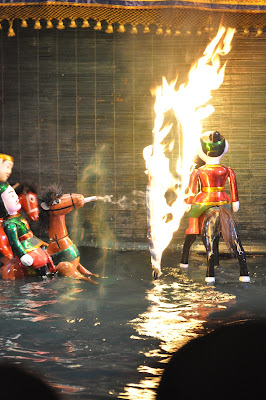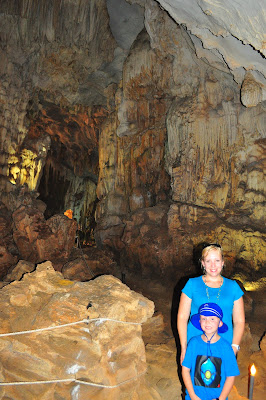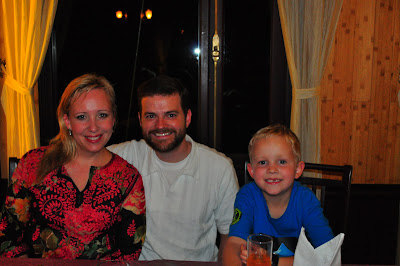After a relaxing few days in Halong Bay, we were ready to tackle Hanoi, the capital city of Vietnam. We visited Uncle Ho, spotted a preserved turtle, walked through a Confucian university, and saw the one Hilton in the world you don't ever want to stay at. If you missed a previous post, you can use the links on the right to view them.
One of the "must see" attractions in Hanoi is Ho Chi Minh's Mausoleum. This is where Uncle Ho himself lies in state, similar to other Communist Party notables like V. I. Lenin in Russia and Chairman Mao in China. We weren't allowed to take any pictures inside - but it was very cold (for obvious reasons) and very solemn. The guards were all dressed in white, which is the Chinese color for death. The Mausoleum itself was built by the Soviets soon after Uncle Ho's passing in 1969. The Soviets also did the embalming, and to this day Uncle Ho makes an annual pilgrimage to Russia for unspecified "maintenance".

Near to Ho Chi Minh's Mausoleum is the Presidential Palace. This edifice was built by the French colonists in the late 1800's as the capital building of French Indochina. It's a beautiful building, but sadly the site was made by clearing away Vietnam's "forbidden city" where the former emperor lived. Uncle Ho lived here for a few years before moving to another location nearby. This is still used to greet official state visitors, including former U.S. President Bill Clinton, who helped normalize the relationship between the U.S. and Vietnam.
Ho Chi Minh was a very simple man, and wanted to live simply. This is the house that Uncle Ho built, which is a few yards away from the Presidential Palace. It is similar to the stilt houses he lived in while fighting in the jungle during World War II.
Here we are standing in front of the One Pillar pagoda. This is also near the Presidential Palace. This pagoda was originally built in the 10th century by the emperor Lý Thái Tông. The emperor was childless, and desired an heir. One night he had a dream that Buddha, while sitting on a lotus blossom, handed the emperor a son. Later, the emperor's wife gave birth to a son, so the emperor built this pagoda to show his gratitude to Buddha. The pagoda is built to resemble a lotus flower, which is why it stands on a single narrow column (representing the stem) and was built in muddy water (which is where lotus flowers grow).
After visiting Ho Chi Minh's mausoleum and the surrounding area, we went to the Temple of Literature. This amazing site is actually an ancient university that was established in the 11th century. The temple is dedicated to the Chinese scholar Confucius.
These stone tablets list the names of those who graduated from the university. They are put on the backs of turtles as a symbol of longevity.
Here is Jennifer and Craig in front of the shrine to Confucius. Confucianism was brought to Vietnam by the Chinese during the time when Vietnam was considered part of China. It spread during the Vietnamese Tran dynasty to other parts of Vietnam as well. Devotees can worship the spirit of Confucius here, and maybe be blessed with a bit of the ancient philosopher's wisdom.

We also visited the Maison Centrale, or central prison, that was built by the French to house political prisoners. You probably know it as the Hanoi Hilton, where American POW's were kept by Vietnam, including U.S. Senator John McCain. This is no longer a working prison, and is instead a museum that shows the depraved conditions the French kept prisoners in. Sadly, the section of the prison that housed the POW's was torn down about ten years ago, so we only saw videos and displays produced by the Communist Party on that part of this infamous building's history. Press and information is tightly controlled by the Communist Party in Vietnam, so the information we were given at the exhibit was a bit one-sided.
Here is one piece of French influence that we found in the Maison Centrale. Yes, this is Madame La Guillotine, intended to be a swift and humane executioner, if there can be such a thing. She was used in the 1800's and early 1900's during the French occupation of Vietnam.
We also visited Hoan Kiem Lake, which is a small freshwater lake in the center of the old district. Legend states that emperor Lê Lợi gave back a sacred sword, called Heaven's Will, to the golden turtle who lives in the lake. To this day, soft shell turtles guard the sword which is still hidden somewhere in the lake.
Here is the actual turtle who took the sword back to the lake. He's preserved on Jade Island in a small shrine built to honor General Tran Hung Dao and his military success in repelling the Chinese invasion during the Yuan Dynasty. Craig wouldn't get near this old turtle who isn't nearly as well preserved as Uncle Ho.
A small bridge called the Huc or Sunrise bridge connects Jade Island in Hoan Kiem Lake to the shore. The flags are being flown in celebration of Vietnam's national holiday on September 2nd.
This is the Trấn Quốc, or "stabilizing the nation" pagoda on a small island in the West Lake in Hanoi. It's very close to the spot John McCain was captured after his airplane was shot down. This temple was built in the sixth century and is supposed to ward off invading nations. If you know the history of Vietnam and Indochina, you know that this pagoda may not have had the desired effect of keeping invaders out.
These are the golden Buddhas in the shrine in the Trấn Quốc temple. The Vietnamese practice the Mahayana version of Buddhism as opposed to the Theravada version practiced in Thailand. in Mahayana Buddhism, anyone can achieve "enlightenment" if he or she is dedicated enough to pursue it.
Like Ho Chi Minh City, the architecture in Hanoi was heavily influenced by the French. Some of these old "tube houses" on a tree lined boulevard near our hotel show the French colonial style pillars and flair from the 1800's and early 1900's. Sometimes we felt we were walking through a European city. The Communist Party flags that were hung in the street were a constant reminder of where we were, though.
We really enjoyed Hanoi. While smaller than Ho Chi Minh City, Hanoi still has an Asian charm with sprinkles of colonial France mixed in. Overall, we enjoyed Vietnam and learned a lot about the history of the region.

























































